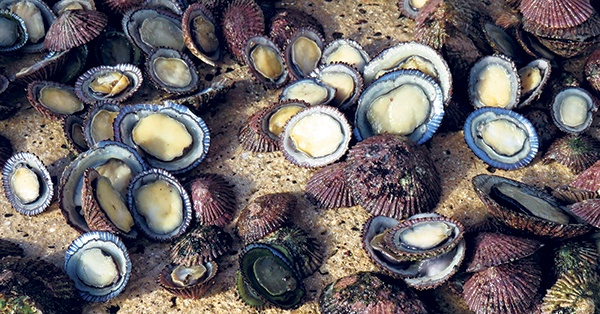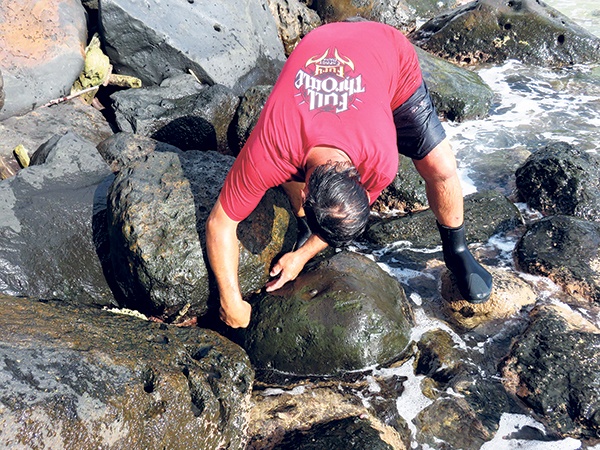Watching Keith Alejo pick opihi is like watching the song “Opihi Man” come to life.
At least several mornings per week, Keith can be found dodging waves, hunting for the tiny limpets that cling to the underside of ocean rocks so that he can eat the tasty morsels that reside inside the shells.
Keith, 50, has been picking opihi, a Hawaiian delicacy, since he was 12 years old.
“My grandfather took me out picking for the first time,” he says. “He had nine daughters, no sons, so he was happy to show me how when I was old enough.”
It takes a lot of time, skill, excellent balance and an abundance of patience to locate opihi, get stable footing between slippery rocks that are constantly being washed over by waves, pry the little shells off the rocks with a small knife, while always keeping a watchful eye on the ocean.
“When you look and you see all the opihi, you wanna just go get ‘em, but you gotta time it between the waves. You always gotta position yourself because you want to be standing and bracing yourself when the wave hits,” Keith says.
But even an experienced opihi picker can get blindsided.
“Just today, I tried to get one more opihi before the wave hit, but waves came from both sides and I wasn’t prepared for that,” Keith says. “I flew about 10 feet and hit my back against the rocks. I had to get right back up because another wave came and then another. You gotta respect the ocean.”
Keith jokes that a person should wear knee pads and shin guards when collecting opihi, but in reality they would add unwanted weight, especially as they absorbed water. He doesn’t even wear gloves. “I gotta feel ‘em with my hand,” he says with a smile.
In addition to skill, there’s also opihi etiquette. “I never pick every one. I only take the big ones,” Keith says, explaining that the rule of thumb is to leave any that are smaller than a quarter. “The big ones, they all hang in the cracks between the rocks. They blend in,” so it’s more difficult to get to them. “The limu (seaweed) is hanging on them. You gotta really look.”
He also rotates the locations where he picks, returning to his favorite opihi beaches only about every two weeks or so.
For all this work, what do these elusive critters taste like? “Like $50 a pound,” Keith says, laughing, though he doesn’t sell what he picks, instead bringing it home for his family or for parties.
In true aloha spirit-style, on the first day we meet him, Keith offers to share some of his freshly-picked opihi with me and my boyfriend, Lincoln. Still standing in the water, wearing his tabis (footwear designed for walking on slippery, mossy rocks), Keith pops a tidbit into Lincoln’s mouth. Lincoln’s eyes get wide and sparkly as he exclaims, “Oh, I like that!”
Opihi taste like nothing I’ve eaten before, more firm than mussels or clams, not slimy at all. They are slightly chewy and salty. They taste fresh, like the ocean.
Opihi is best eaten raw, Keith says, or his other favorite way, chopped and tossed with fresh poke. He also says opihi are delicious grilled and that the meat pops right out of the shells easily once they heat up. “You put shoyu and Tabasco on top,” he says. “There’s no limit to eating them. It’s like candy.”
Lincoln’s favorite preparation is to drizzle them with olive oil, sprinkle on some of Kauai Coffee’s Big Bruddah’s Mother’s Garden Coffee Rub then grill them on the barbecue.
“When you’re out there, you see so many opihi, it gives you the drive to keep going,” Keith says. “It’s hard work, but it’s worth it.”
•••
Pamela Varma Brown is the publisher of “Kauai Stories,” and the forthcoming “Kauai Stories 2,” which will include a longer version of Keith Alejo’s story.






